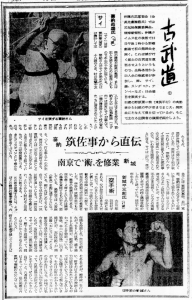Kobudō 1: Kina Shōsei and Shinjō Heisaburō
[ Okinawa Times ] November 15, 1961
Kobudō 1
With the support of the Cultural Property Conservation Committee, the Ryūkyū Shimpō and the Okinawa Times Newspapers, the Okinawa Kobudō Kyōkai (President Higa Seitoku) will held its first demonstration on November 26th at 13:00 at Naha Theater. This is organized in order to help the resurrection of native kobudō on the verge to disappear. More than 50 authorities from all regions of the island will participate performing around 60 demonstrations among which Bō, Sai, Kama, Nunchaku, Tinbē, etc… From the venerable 83 years old Nohara Kamaichi (Kochinda Village) to 24 years old young men, all are enthusiastic preparing for this demonstration. At this stage, let’s introduce the major demonstrators.
Direct transmission from the police officer
Kina Shōsei (79)
Sai
In the past, sai was worn by Chikusaji (hori) (1) and was used to protect the king, control the crowd or to arrest criminals. It resembles the Jitte of Mainland Japan.
Mr. Kina started the practice of sai at the age of 18, receiving instruction from the seniors and friends of the village. The birthplace of Mr. Kina, Shimabukuro (Koza City) is extremely famous for sai and it is said that it was popularized among the youth of the village as one kind of self-defense. However, it seems that this was only a self-taught style where people learned from mimicking policemen.
Today, there are many experts of sai in Okinawa but there exists no ryuha (2) and kata are not uniformed. The sai technique that Mr. Kina practices was directly transmitted from an Ufuchiku (official title) policeman who performed his duties at Shuri Castle, thus making it an orthodox school. The major techniques of sai are about “hitting, blocking, thrusting and knocking down”, thus making it a martial art for self-defense. Mr. Kina says that he teaches his students advocating, “Under the sky, one cannot commit bad actions, there is no first attack in sai.” For 32 years, he has worked as a teacher and nowadays lives the rest of his life quietly as a Christian. Among his students are Kyan Shin-ei, Izumikawa Kantoku and Kina Shōshin who are famous as sai experts. Laughing with a big voice Mr. Kina jokes saying, “I am already an 80 years old grandpa” but his handling of the sai is sharp. During the soon coming demonstration at Naha Theater, he intends to show the techniques and higher skills that he has spent a lifetime to learn. He was born in in 1882. (3)
(1) “Chikusaji” refers to police force or policeman. The term “hori” designates a policeman of the time of Edo era.
(2) “Ryuha” means school or style
(3) Kina sensei passed away in 1981.
Return to the top page of the series
**********
Studying “jutsu” in Nanking
Shinjō Heisaburō
(47)
Karate-jutsu (1)
He was born in 1914 in Yomitan Village Aza Uza. His father being fond of karate, he became familiar with karate since his young years. On the suggestion of his father, he crossed over to Nanking China at the age of 17 and learned karate-jutsu at the dojo of Kan Mei sensei (2). Karate is not about Buki (weapon) or Gei (arts). The purpose is to temper the mind (3). Karate-jutsu… Mr. Shinjō explains that the meaning of “Jutsu” is the cultivation of the mind. During the demonstration, he is scheduled to put a wire through his arm (4). Since the wire is like a fine metal chopstick, encouraging himself with a kiai, he will pass the wire through his arm instantly. Not a drop of blood is shed. No pain is felt. It is hard to believe that such a skill is of a human being.
To master such a technique, one needs a considerable amount of spiritual training and Mr. Shinjō devoted six years. Although he has developed a strong body conditioned through karate and a thick wad of muscles, he recalls the pain that comes with conditioning.
After the war, he was evacuated to Mainland Japan (Kagoshima). When his Highness Prince Takamatsu visited Kagoshima, he demonstrated karate-jutsu at a welcoming party. So far he had put 18 times a wire through his arm, but the demonstration he did for the reception in honor of Prince Takamatsu was the one that marked him the most. Seeing the performance, the Prince asked him if it wasn’t painful.
Once the wire go through, it is fine. But the mental concentration until realization is very tiring both nervously and physically. “I am very happy to be able to show my skill in public. According to my capacity of applying technique on this day or not will be a turning point. Even if I am the only one in Okinawa to be able to do this karate-jutsu, the Kobudō Association has recommended me, therefore, I have to do my utmost…” says he enthusiastically grabbing a wire. Currently, he runs a shoe-making store in Nishinjō, Naha City (5).
(1) Shinjō Heisaburō is the uncle of Shinjō Heitarō, who is the master of Matsuda Yoshimasa. The 3 men participated to the demonstration. According to the latter, he performed the kata Chintō while Shinjō Heitarō performed Kusari-gama.
(2) No further information on Kan Mei. The reading of the kanji is not sure as it is most likely a Chinese name. It is not sure if it is Kan-mei or Kan as a family name with Mei/Akira as a given name…
(3) In the text, “Seishin no tanren”, that could be translated as tempering or conditioning of the spirit or mind.
(4) A 3.5 mm diameter wire.
(5) At the entrance of Kuninda, the Kume Village of nowadays’ Naha, was a gate called Kume Ufu-mon (big gate). At the end of Kume Street, north east, used to be Nishinjō-mon (East gate). Today, the police box at the end of the street is still called Nishinjō Kōban.

